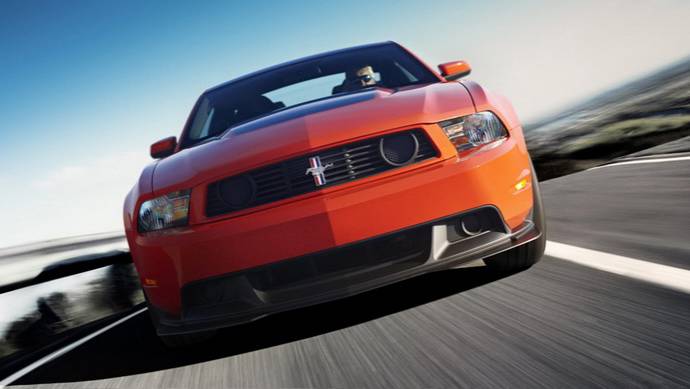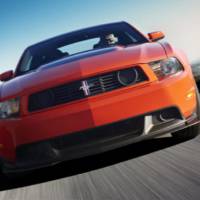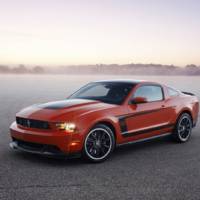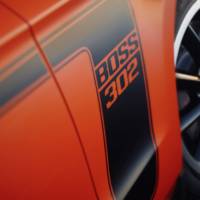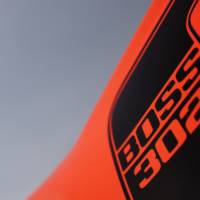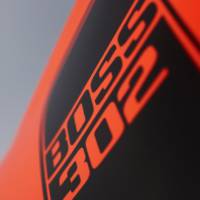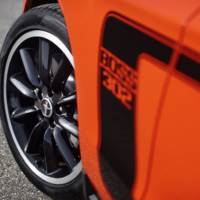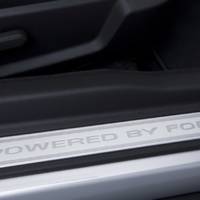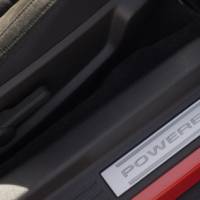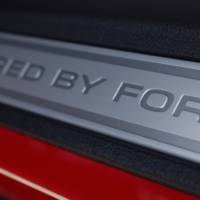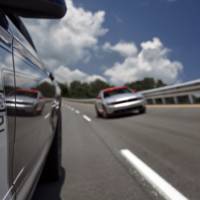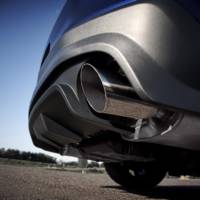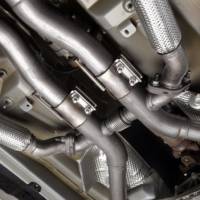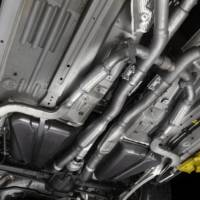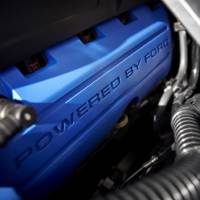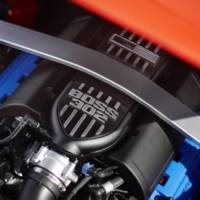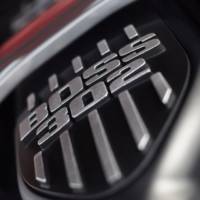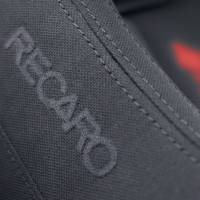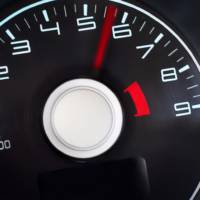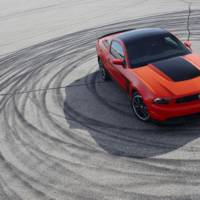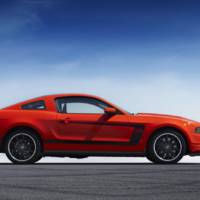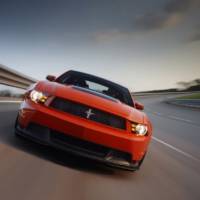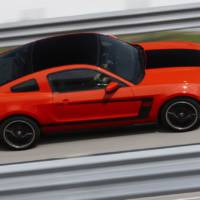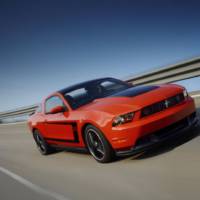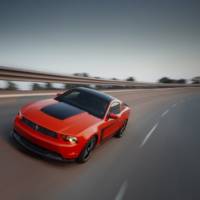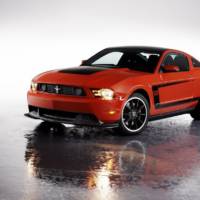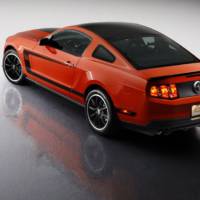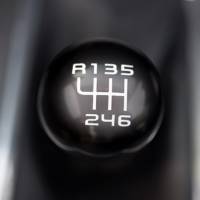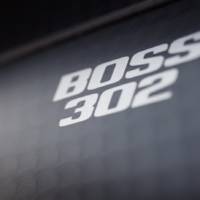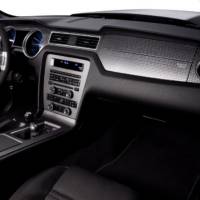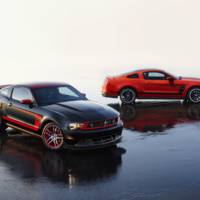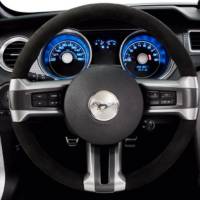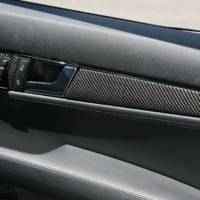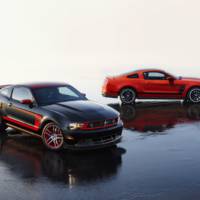The Blue Oval has published photos and details with the 2012 Ford Mustang Boss 302 which is inspired by the classic model from 1969 and which comes with many improvements all around.
Powered by a revised version of the 5.0-litre V8 found in the Mustang GT which received a composite intake system, custom camshafts, a race-spec crankshaft and a new exhaust system, the 2012 Ford Mustang Boss 302 delivers 440 horsepower (328 kW) and 515 Nm of torque.
Performance figures for the 2012 Ford Mustang Boss 302 were not specified, but they are surely improved, as besides performing modifications to the engine the automaker has also added a higher-rate coilover suspension with stiffer bushings, and an also improved rear stabilizer.
On the optional list, the 2012 Ford Mustang Boss 302 also comes with an electronic steering system, traction and stability control systems and adjustable shocks and struts.
At the exterior the 2012 Ford Mustang Boss 302 features a new grille, a front spoiler lip, side decals, and 19 inch alloys wrapped in Pirelli P Zero tires.
Inside the 2012 Ford Mustang Boss 302 there is the redesigned instrument cluster, sports seats from Recaro, Alcantara leather and various metallic accents.
The 2012 Ford Mustang Boss 302 price was not announced yet.
Ford press release :
The all-new 5.0-liter dual-overhead camshaft (DOHC) V8 in the 2011
Mustang GT already is the most powerful naturally aspirated production
V8 Ford has ever produced. To make it worthy of the Boss name, Ford
engineers tweaked more than a few bits of the engine.
They reengineered an entire dynamometer cell to handle the engine’s
projected 7,500 rpm redline; put the first engines into Boss 302R race
cars and sent them straight onto the track; and they designed a torture
test equivalent to running the Daytona 250 race flat-out more than 175
times – in a row.
Only when the 440-hp V8 passed these tests, ensuring maximum power
output without sacrificing durability, reliability and drivability, was
it worthy of being called a Boss.
Bulletproof and blower-free
Planning began with a small group of engineers within the 5.0-liter V8
team. Starting with open minds and enlisting the help of two members of
the original 1969 Boss 302 design team, the group began working its way
toward the ultimate evolution of the new 5.0-liter: 440 horsepower and
380 lb.-ft. of torque, along with a broad, flat output curve all the way
through its projected 7,500 rpm redline.
The Mustang team knew a supercharger would be the simplest way to
extract significant power improvements from the new 5.0-liter V8, but
they elected not to pursue forced induction for the 2012 Boss to stay
true to the original Boss 302 engine.
“The core group of engineers on the Boss 302 engine understands and
respect the heritage of the name and the history behind the original
engine,” explains Mike Harrison, Ford V8 engine program manager. “The
first Boss 302 was a specially built, free-breathing, high-revving small
V8 that gave it certain desirable characteristics on a race course –
and we capture that essence in the new engine.”
The team also realized the additional hardware meant more weight, the
bane of any racing program and the opposite of what the Boss design
team was attempting to achieve. Instead, the same technology that has
made the new Mustang GT engine such a formidable force was applied to
the Boss 302.
“In keeping with the spirit of the original, the new Boss 302 engine
achieves its maximum power output at speeds at or above 7,500 rpm,” says
Harrison. “Unlike the original engine, however, low-speed torque and
driveability are uncompromised thanks to twin independent variable
camshaft timing (Ti-VCT) technology and computer-aided engineering
design tools.”
Harrison and his team began exploring Boss 302 concepts starting with
the engine’s ability to breathe – essential to the production of
horsepower. Because credible track performance requires high power
production between 5,000 rpm and 7,000 rpm, the team needed a new
approach to intake manifold design.
Borrowing from the Ford Daytona Prototype engines, the resulting
short-runners-in-the-box design virtually eliminates lag when the
throttle is snapped open while producing peak power output at high rpm.
“The effect of the new intake design is dramatic,” says Harrison.
“When I took the prototype car to Mustang Chief Engineer Dave Pericak,
he took a short drive, tossed me the keys and said ‘Book it…it’s in the
program.’ He knew what we were onto, and that’s really the point where
the Boss 302 was born.”
To take advantage of the racing intake manifold, cylinder head
airflow was fully optimized by CNC porting the entire intake and exhaust
port and combustion chamber. The painstaking machining process takes
2.5 hours per head to complete.
To accompany the higher peak-power engine speed, the team had to
engineer a lightweight, high-speed valvetrain and bulletproof
reciprocating assembly that would not only hold together for
150,000-plus miles but also produce power at peak rpm.
“What most people don’t realize is that engine stresses increase
exponentially as engine speeds rise,” explains Harrison. “So moving up
from GT’s 7,000 rpm redline required significant re-engineering of many
different parts. Sacrificing reliability and usability over the GT
engine was never an option.”
Some of the Boss-specific parts contributing to the Boss 302 V8’s output and durability include:
- Revised composite intake system with shorter runners, inspired by Daytona Prototype racing engines, for high-rpm breathing
- Forged aluminum pistons and upgraded sinter-forged connecting
rods for improved strength, needed for the higher combustion pressures
and engine speeds - New high-strength aluminum-alloy cylinder heads with fully
CNC-machined ports and chambers for exceptional high-rpm airflow without
sacrificing low-speed torque - Lightened valvetrain components to provide excellent dynamic performance up to speeds well above the engine redline
- Sodium-filled exhaust valves for improved heat dissipation
- Race-specification crankshaft main and rod bearings for higher load capability and improved high-speed durability
- 5W50 full-synthetic oil with engine oil cooler for improved oil
pressure and longer-lasting lubrication during extreme racing conditions - Revised oil pan baffling for improved oil control under racing conditions and during cornering loads greater than 1.0 g
Close connection with race teams
Contrary to normal engine development protocol, the first batch of
durability test engines weren’t installed in an engine dyno. Instead,
thanks to a request from Ford Racing, they went straight to the track.
“Ford Racing had challenged the Boss engine team to give them the
first available Boss 302 engines,” explains Harrison. “They came to us
in August 2009 and told us they needed engines as soon as possible to
build a limited number of Ford Racing Boss 302R cars for the January
Daytona race. They got the engines 12 weeks later and the team got five
Boss 302R cars prepped for the January race. This gave us a fantastic
opportunity to be able to get full-on race experience with the engine so
early in the program.”
The Boss engines have run reliably all season without a single
mechanical failure. Boss 302R cars have also racked up the most laps led
so far this season in Grand-Am racing.
Using race telemetry, the Boss team has been able to gather on-track
data to help optimize engine calibrations, oil pan designs and cooling.
In order to engage in virtual racing whenever they needed, the team used
the telemetry data to re-create a hot lap at Daytona on the dyno back
in Dearborn, allowing further fine-tuning.
“Working with Ford Racing has been invaluable,” said Harrison. “They
were a wealth of information for setting up torque and power curves for
road racing and for identifying areas of concern during track runs that
we wouldn’t have considered if we were just building a hot street
engine. Every Boss 302 owner will benefit from their contributions to
the program.”
Production engine durability testing
Despite its racing heritage – and the rigors of track-day testing – the
Boss 302 V8 is still a production Ford engine, built alongside the
5.0-liter GT engine at Essex Engine Plant in Ontario, Canada. That means
it has to meet or exceed all the standard durability testing every Ford
engine is required to complete.
The high-winding engine presented a challenge: The engine had no
trouble staying together at its redline, but the Ford durability
dynamometers weren’t designed to operate at the speeds the Boss engine
was capable of.
“Ford had no engine test cells built to run at that kind of sustained
speed,” said Harrison. “Ford Racing had one, but it wasn’t instrumented
to do production durability testing. So we had to re-engineer the dyno
cell with new balancers and jackshafts so the dyno wouldn’t fly apart
running at redline hour after hour.”
Once an adequate test stand was configured, the Boss engine was run
at its full rated output for tens of millions of cycles, eventually
outperforming its specifications at every stage of testing. Engineers
calculated that the test regimen was equivalent to running the Daytona
250 race flat-out more than 175 times – in a row.
Team members also devised an additional durability test specific to
the Boss 302 engine – one that reflects the unique demands of Boss
drivers. The engine was subjected to a regimen simulating 1,500
quarter-mile races typical of events at drag strips across the country.
“Even though the production Boss engine is designed to be very close
to a full race engine, it had to achieve the same vehicle durability
signoff any other production engine requires,” says Harrison. “Then it
went on to get the track durability test signoff too. It’s really an
engineering accomplishment that a Boss owner can thrash his car on the
track and still expect the same outstanding reliability that the owner
of a regular Mustang GT will enjoy.”
2012 Ford Mustang Boss 302 video :

